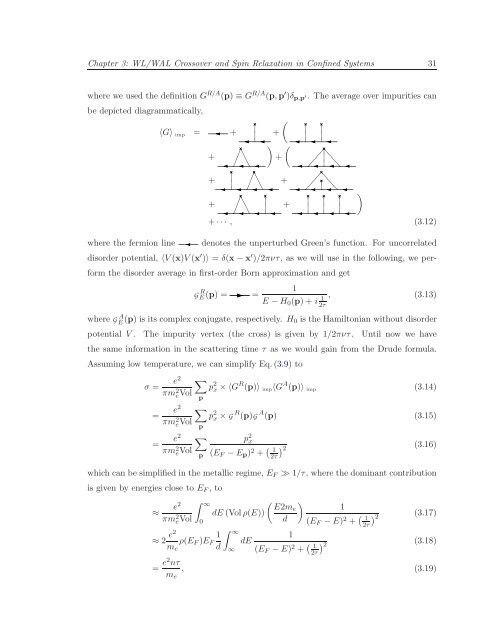Itinerant Spin Dynamics in Structures of ... - Jacobs University
Itinerant Spin Dynamics in Structures of ... - Jacobs University
Itinerant Spin Dynamics in Structures of ... - Jacobs University
Create successful ePaper yourself
Turn your PDF publications into a flip-book with our unique Google optimized e-Paper software.
Chapter 3: WL/WAL Crossover and <strong>Sp<strong>in</strong></strong> Relaxation <strong>in</strong> Conf<strong>in</strong>ed Systems 31<br />
where we used the def<strong>in</strong>ition G R/A (p) ≡ G R/A (p,p ′ )δ p,p ′. The average over impurities can<br />
be depicted diagrammatically,<br />
(<br />
〈G〉 imp = + +<br />
) (<br />
+ +<br />
+ +<br />
+ +<br />
)<br />
where the fermion l<strong>in</strong>e<br />
+··· , (3.12)<br />
denotes the unperturbed Green’s function. For uncorrelated<br />
disorder potential, 〈V(x)V(x ′ )〉 = δ(x−x ′ )/2πντ, as we will use <strong>in</strong> the follow<strong>in</strong>g, we perform<br />
the disorder average <strong>in</strong> first-order Born approximation and get<br />
G R E(p) = =<br />
1<br />
E −H 0 (p)+i 1 , (3.13)<br />
2τ<br />
whereG A E (p) is its complex conjugate, respectively. H 0 is the Hamiltonian without disorder<br />
potential V. The impurity vertex (the cross) is given by 1/2πντ. Until now we have<br />
the same <strong>in</strong>formation <strong>in</strong> the scatter<strong>in</strong>g time τ as we would ga<strong>in</strong> from the Drude formula.<br />
Assum<strong>in</strong>g low temperature, we can simplify Eq.(3.9) to<br />
e 2 ∑<br />
σ =<br />
πm 2 e Vol p 2 x ×〈G R (p)〉 imp 〈G A (p)〉 imp (3.14)<br />
p<br />
e 2 ∑<br />
=<br />
πm 2 e Vol p 2 x ×G R (p)G A (p) (3.15)<br />
=<br />
p<br />
e 2 ∑ p 2 x<br />
πm 2 e Vol p (E F −E p ) 2 + ( )<br />
1 2<br />
(3.16)<br />
2τ<br />
which can be simplified <strong>in</strong> the metallic regime, E F ≫ 1/τ, where the dom<strong>in</strong>ant contribution<br />
is given by energies close to E F , to<br />
e 2 ∫ ∞<br />
( ) E2me<br />
≈<br />
πm 2 dE(Volρ(E))<br />
eVol<br />
d<br />
≈ 2 e2<br />
m e<br />
ρ(E F )E F<br />
1<br />
d<br />
0<br />
∫ ∞<br />
∞<br />
dE<br />
1<br />
(E F −E) 2 + ( 1<br />
2τ<br />
1<br />
(E F −E) 2 + ( 1<br />
2τ<br />
) 2<br />
(3.17)<br />
) 2<br />
(3.18)<br />
= e2 nτ<br />
m e<br />
, (3.19)
















